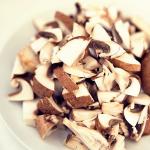Forshmak. Classic herring recipe
This is usually made from fish, but sometimes meat or offal is used to prepare it. The traditional dish also includes apples, eggs, bread, butter and onions. Sometimes there are quite surprising variations. For example, instead of the usual products, processed cheese or tomato juice is added to the snack. However, today we want to tell you how the traditional classic is prepared as follows:
- Cut three slices from the loaf, place them in a bowl and cover with water.
- Peel the green apples (we will need one and a half pieces), remove the core and cut them into cubes.
- Remove the peel from the onion and then cut it into several small pieces.
- Place the prepared products in the bowl of a food processor, add 500 grams of salted herring (fillet) and two boiled eggs.
- Grind the ingredients and then transfer the snack to a separate bowl. If you wish, you can finely chop all of these products with a knife. Serve the mincemeat with slices of black bread.
Israeli cuisine is known for other delicious dishes. We will talk about some of them below.

Homemade hummus recipe
This dish is very popular among the peoples of the Near and Middle East. It is usually prepared from chickpeas, and then the puree is seasoned with any vegetable oil and a variety of spices. We would like to bring to your attention a classic hummus recipe. It is not difficult to prepare it at home. So:
- Soak 100 grams of chickpeas in hot water overnight.
- In the morning, let the cereal cook in the same water for two hours.
- Once the peas have softened, drain off most of the liquid (there should be about one cup left).
- Place the chickpeas in a blender, add 20 grams of olive oil, and then puree until smooth.
- Place 40 grams of tahini in a bowl and grind the ingredients again.
At the very end of cooking, add paprika and cumin.

Cold eggplant appetizer
“Baba Ganoush” is the original name of the dish that we will make from blueberries, garlic, hot peppers and cilantro. Please note: according to the rules, eggplants must be cooked over an open fire, so you can prepare this appetizer at the dacha or during a picnic. So, how to make dishes read below:
- Take two eggplants, brush them with oil, pierce them in several places, and then wrap them in foil. Place the vegetables in the oven and roast until done (just remember to turn them in time).
- Remove the skin from the eggplants and finely chop the pulp with a knife. Do the same with half a hot pepper, two cloves of garlic and a bunch of cilantro.
- Season the appetizer with oil and mix well.
Serve it with flatbread or thin bread slices.

Shakshuka
Ideal for breakfast, as it is scrambled eggs cooked with stewed vegetables. The recipe for this dish is very simple, and Jewish shakshuka is prepared as follows:
- Peel two onions and then chop them very finely.
- Cut two bell peppers into cubes, and one chili into rings.
- Peel the tomatoes (about 500 grams) and then cut the pulp into cubes.
- In a preheated frying pan, first fry the onions, then add the peppers to it, and at the very end - the tomatoes.
- Add a pinch of salt and simmer everything together until the excess liquid evaporates.
- After this, make several holes in the vegetables with a spoon and break the eggs into them.
Season the dish with salt and spices, wait until it is cooked, and serve.

Hamin
The classic version of the traditional soup takes 24 hours to prepare, but we suggest reducing the time to 11 hours. You can read the recipe for Jewish soup below:
- Soak 200 grams of beans overnight.
- Peel one onion and ten cloves of garlic. Chop the first product randomly, and cut the second into slices. Fry onions and garlic in vegetable oil.
- Rinse a kilogram of beef and then cut into small pieces.
- Place the suitable beans at the bottom of a large clay pot, place 150 grams of peas and 75 grams of lentils on it.
- Next, add the sliced potatoes, onions and garlic. This layer needs to be salted.
- Dice the celery and zucchini, then place the vegetables on top of the potatoes.
- Next, add another 75 grams of lentils.
- At the very end, place the potatoes again and the meat on it.
- Season the dish with turmeric, cumin and ginger.
- Dissolve four tablespoons of paprika in water and pour the liquid into the pot.
- Place the hamin in an oven preheated to 180 degrees. Do not forget to periodically add water to the pot to replace the water that has already evaporated.
- Two hours before the soup is ready, remove it from the oven and add chopped parsley to it.
- Wrap 120 grams of washed rice in gauze (preferably in several layers). Place the structure on top of the pot and secure it with a lid so that the rice is steamed.
- Place the finished dish on plates and add two tablespoons of steamed cereal to it.
The appearance of hamin is closely connected with the Sabbath, when believers were forbidden to work. This means that they could not cook. Therefore, a delicious soup of beans and meat languished in the oven all the time that the family spent in the synagogue.

Aspic
The Jewish dish "Regel Krusha" is a jellied meat made from cow's feet. The recipe is quite simple:
- Prepare two pieces. cow legs, some beef and three pieces of chicken (you can use wings or thighs).
- Peel one carrot and remove the outer skin from the onion.
- Boil five chicken eggs.
- Cook the legs over low heat, and after a while add prepared vegetables, meat, salt and allspice to it.
- When the beef is boiled, you need to take it out and throw away the vegetables and spices.
- Separate the meat from the bones, separate it into fibers and place it in jellied meat molds.
- Pour the broth into the molds and decorate the future dish with halves of boiled eggs.
Place the jellied meat in the refrigerator for a while so that it can harden.

Eggplant salad
As you know, Israeli cuisine is famous for its variety of delicious Lenten dishes. And this time we recommend that you prepare a spicy dish. The recipe for the dish is very simple:
- Peel three eggplants, cut the flesh into cubes, add salt, place in a colander and leave them alone for one hour.
- Grill three red bell peppers. When ready, transfer them to a bowl and cover with cling film. After an hour, remove the skin from the peppers and cut them into small cubes.
- Fry the eggplants in small portions in olive oil with garlic. Place the prepared vegetables on a paper towel for a while to remove excess fat.
- Combine the prepared products with chopped herbs, salt, two teaspoons of sugar and a spoon of vinegar.
Mix the products and leave to infuse in the refrigerator overnight.
Conclusion
Israeli cuisine is very bright and rich. It contains meat, fish, poultry, a lot of herbs and fresh vegetables. Local chefs also enjoy flavoring their dishes with spices and seasonings.
Although Israel belongs to the Mediterranean region, it is conventionally divided into several parts. Ashkenazi dishes came along with Jews from Poland and Hungary. Sephardic cuisine can be recognized by its "oriental" tastes. For example, these include couscous and shakshuka. The Arab population of the country also influenced the national cuisine and gave it some dishes typical of North Africa.
Some foods are prohibited for Israelis, while others can only be eaten if they are not combined with others. This interesting feature stands out from other culinary traditions.
Israel is a holy land. An amazing state that was formed relatively recently. Food in Israel is like a country - an incredible combination of different cultures, all kinds of national dishes, a fusion of East and West.
Returning to their ancient land, the Jews not only brought with them many languages and traditions, but also the culinary heritage of different countries, which, combined with indigenous dishes, created the multifaceted Israeli cuisine. It also shows the close influence of Arabic traditions.
Israel, Tel Aviv. Photo: http://www.flickr.com/photos/thorbak2006/
The national cuisine of Israel is divided into Ashkenazi and Sephardic. Sephardic refers to the Jewish people from the countries of the Middle East, its food is spicy, rich, with aromatic spices and herbs. Ashkenazi is associated with the Jewish people from Eastern and Western Europe; here the dishes are more modest, with flavor nuances familiar to Europeans.
It should be noted that Jews follow the religious laws of kashrut in preparing and consuming food. For example, pork and shellfish are prohibited. Dairy products should be prepared and eaten separately from meat dishes.
Food prepared according to the laws of kashrut is considered “kosher,” that is, “permissible.” In Israel there are “kosher” restaurants and cafes, which are divided into dairy and meat, and you can also find “non-kosher” ones with Chinese, French, and Russian cuisines.
Snacks and street food in Israel
A traditional Israeli dish is hummus. A unique snack made from chickpea puree (chickpeas - chickpeas), olive oil, garlic, onion, lemon juice and spices. Sometimes tahini, a paste sauce made from sesame seeds, is added to hummus. Hummus can serve as an appetizer, a side dish, or a main dish.

As a street food, it is added to pita, round pocket-shaped bread, making a very nutritious and healthy fast food.
In general, street food is common in Israel. There are many different snack bars, stalls, and benches where you can quickly grab something to eat.

Falafel. Photo: http://www.flickr.com/photos/ingmar/
The most popular fast food is the Arabic dish falafel. It is made from hummus, which is ground into a homogeneous mass, made into balls and deep-fried. Falafel is served in pita bread, along with a salad of fresh vegetables, and topped with tahini sauce.

Falafel in pita bread with salad. Photo: http://www.flickr.com/photos/ryry9379/
Burekas pies are also in great demand. They are made from thin unleavened or puff pastry filled with cheese, potatoes, and spinach.
Be sure to try the Israeli kebab Al ha-esh (translated as “on fire”) - meat cooked on the grill. It is not inferior in popularity to hummus.
Main dishes of Israeli cuisine
In Israel, according to religious laws, cooking food on the Sabbath is not allowed, with the exception of food prepared in advance, which is placed in the oven the day before, on Friday, and simmered over low heat until the next day.
One such Shabbat dish is cholent. In Sephardic cuisine it is called hamin. A hearty roast made from meat, potatoes, beans, onions, chickpeas and spices. It is prepared in a pot and served on Saturday morning.

Cholent (khamin). Photo: http://www.flickr.com/photos/missvincci/
If you are a lover of scrambled eggs, then try a dish called shakshuka. A dish of eggs in a spicy sauce of tomatoes, onions, and bell peppers. There are many recipes for shakshuka. Traditionally it is served in a cast iron skillet with bread.

Egg dish - Shakshuka. Photo: http://www.flickr.com/photos/aragornital/
Among the fish dishes, it is worth noting the signature dish “St. Peter’s Fish” - grilled Galilean tilapia. Why St. Peter's? According to Biblical legends, it was this fish that Peter caught and found in its mouth a coin with which he paid the tax for the temple.

St. Peter's fish - Tilapia. Photo: http://www.flickr.com/photos/junnbeve/
Israeli sweets
Israel offers many different confectionery products: baklava, donchikes fun tvore, blinchikes - pancakes with various sweet fillings, homentash - pies with poppy seed filling, candied fruits and much more.

Pies - khomentash. Photo: http://www.flickr.com/photos/danb2007/
An interesting dessert that is definitely worth trying is Knafeh. This incredibly tasty and tender delicacy is made from Kadaif vermicelli and goat cheese. When serving, knafeh is poured with sugar syrup and sprinkled with almonds, walnuts or pistachios.

Israeli sweets - Knafeh. Photo: http://www.flickr.com/photos/visit_jordan/
The traditional Israeli sweet is Bamba. Corn sticks soaked in a thin layer of peanut butter. They are incredibly popular; not a single holiday is complete without them.
Beverages
Israel has a very developed coffee culture. It is prepared in different ways: latte, iced, Turkish coffee flavored with cardamom, espresso.
In the heat, mint tea will refresh you, as well as freshly squeezed juices, especially pomegranate juice.
Among alcoholic drinks, local brands of beer Goldstar (dark) and Maccabee (light) are popular.

Israeli beer - Maccabee and Goldstar. Photo: http://www.flickr.com/photos/asner/
In recent years, winemaking has been developing rapidly here. The most prestigious wines are the Yarden, Gamla, Golan and Carmel series, which have already won many awards at international festivals.
Of the strong alcoholic drinks, the most common is arak (Lerous Premium Arak). Aniseed vodka, 50% strength. Usually before use it is diluted with water and ice is added.

Strong alcoholic drink - Arak. Photo: http://www.flickr.com/photos/56872425@N08/
Of course, Israeli cuisine deserves close attention in terms of gastronomic tourism. Israel is a land of contrasts, with original dishes filled with spicy and unusual flavors that never seem boring.
It is quite difficult to give a precise definition of the concept of “Israeli cuisine” and highlight its distinctive features from other cuisines of the world, if only because in essence it is a kind of “fusion” of a variety of national cuisines, whose representatives are adjacent to each other in the Promised Land.
But, perhaps, one of the distinctive features of Israel is that, unlike most other countries, here the national cuisine is most clearly and fully represented in the field of fast food, i.e. ordinary street food, while the food in most restaurants is neutral European. If we talk about the price category, even ordinary fast food will be expensive by Russian standards, so food was the main expense item for us.
I can’t say that I have become fully acquainted with Israeli cuisine and have studied it, but I will try to tell you something.
01. Our acquaintance with Israeli cuisine began with... a bakery. Well, where else can tourists who have just arrived in Jerusalem replenish their strength at 6 am? ;) Israeli bakeries are a special article. There are a lot of bakeries, they all work according to similar principles, but no two bakeries are identical. Bread is far from the main reason why people come here. Here you can have breakfast, lunch and dinner. Moreover, prices in bakeries are quite affordable. The main share of the assortment is made up of puff pastries: sweet, salty, with cinnamon, chocolate, apple, etc. They are usually sold by weight. In addition to puff pastries, you can find pizza, sandwiches, salads, donuts, pastries, pies, and hot drinks. 
Let me make a reservation right away that in most Israeli restaurants, cafes, and snack bars, kashrut is observed. This, of course, leaves an imprint on food and the rules for its preparation. According to the rules, it is prohibited to mix meat and dairy products. It is allowed to consume the meat of artiodactyl ruminants and poultry. As for fish, only those that have fins and scales are used.
However, there is a lot that is truly beautiful and tasty in Israel and that largely determines the Israeli diet. These include a variety of dairy products, olive oil, olives, fruits and vegetables, chickpea and sesame dishes.
02. Meat, fish and poultry dishes cooked over an open fire are widespread in Israel. This method is used to fry steaks, kebabs, kebabs, and chicken wings. Shawarma is very popular. 
03. Shawarma made from lamb, beef or turkey can be placed either as a separate dish on a plate or as a filling in pita - a flatbread made from unleavened dough. 
04. A dish without which it is difficult to imagine Israeli cuisine is also shakshuka. Original Middle Eastern scrambled eggs, fried in olive oil. It contains tomatoes, onions, peppers and spices. In one of the Telaviv restaurants not far from our hostel, we found a large selection of all kinds of “shakshuka” with different servings. In the photo I have shakshuka with hummus - it’s incredibly delicious. Fresh bread is dipped either in scrambled eggs or in hummus and eaten with the obligatory “moo and shake of the head” :). 
By the way, hummus (chickpea puree, also known as chickpeas, with the addition of olive oil, lemon juice and spices) is considered an independent dish, which is usually eaten with pieces of pita bread. I tried hummus once at the Moscow restaurant "", and then this dish did not impress me. While in Tel Aviv, we stayed at a hostel in the Old City, and it was there that I tried the freshest hummus for breakfast and became its ardent fan.
05. I'll tell you a little about fast food. There are a lot of fast food outlets in the country and they are divided into two categories: traditional fast food and modern. Traditional fast food is small shops with falafel (small balls of chickpeas or beans fried in oil with spices) and shawarma, usually located in the bazaar. This category also includes sandwich shops and small pizzerias. 
06. There are no ready-made recipes; you make sandwiches yourself from available ingredients: cheese, feta cheese, tuna, vegetables. 
The modern American type of fast food is distributed mainly in the form of food courts in shopping centers.
07. Israel is a coffee country. They drink tea much less often than coffee here. The coffee we drank was good everywhere, and some sweets were often served with it. We found this cafe, run by a very hospitable Palestinian, while wandering through the streets of the Old City in Jerusalem. 
08. Then we dropped in here more than once for drinks and to “chat.” 
09. By the way, we ate in the Old City of Jerusalem only twice, once in the Muslim quarter. I have no complaints: the portions are large, the food is tasty and relatively inexpensive. The main course (which is usually meat in any case) is served with a pleasant bonus in the form of a variety of pickles, which is also good news. 
10. We ate plenty of delicious kebabs, as well as kebabs, but they were nothing in the Muslim quarter. 
11.
12. Another variation of the sandwich bought on Jaffa Street in Jerusalem. The filling contains potatoes, eggs, cucumbers, fried tomatoes. 
13. And, of course, a large cup of cappuccino with cinnamon. A chocolate with an Israeli flag was a bonus. ;) Patriotism in everything. 
14.
15. For the second time in the Old City of Jerusalem, we visited some street cafe already in the Jewish quarter. It’s funny, but true: the portions are smaller, and it costs more and more. Sandwiches with fish and small (to bite) quiches. 
16. Not far from our hotel in Jerusalem, we noticed a diner, near which crowds always gathered. The large pita was wrapped with a choice of fillings: falafel, fried eggplant, vegetables, fried potatoes, hummus or tahini as a “spread.” It turned out to be a huge pita and it cost quite reasonable money. 
17.
18. In addition to these pitas, I also came across small triangular or square pies made of puff pastry stuffed with cheese, spinach, mushrooms or potatoes. They are called burekas. My husband tried this pie and was quite pleased. 
19. While in Israel, we rarely “indulged” ourselves with non-fast food. On the last evening in Jerusalem, we visited a cafe, so to speak, to shuffle to our hearts’ content, where in addition to baked potatoes (by the way, it was delicious!) I ordered a traditional Israeli salad. These are finely chopped tomatoes and cucumbers, to which white or purple onions and red (green) bell peppers are added. This salad is seasoned with salt, lemon juice and olive oil. Regarding the salad, I can say one thing: expectations were too high. But perhaps it’s just a matter of a particular cafe. 
20. Potatoes in sauce with carrots and cheese. 
21. Perhaps it was shakshuka that became my favorite dish in Israel. Hot, steaming, it reminded me so much of my childhood, when my Belarusian grandmother cooked us, her grandchildren, scrambled eggs, albeit with cracklings, and how delicious it was to dip freshly baked bread into it. Mmm... 
22. Probably, true connoisseurs of Israeli cuisine will want to object to me, noting that shakshuka is far from the only specialty that you definitely need to try in Israel. Gefilte fish, mincemeat, chicken broth, matzo dishes come to mind (though this is more Ashkenazi cuisine). Sephardic Jews introduced popular dishes such as couscous and mafrum (potatoes stuffed with ground meat) into Israeli cuisine. To me, Israeli cuisine is an intricate mixture where the dishes reflect the national flavor and allow the residents to bring something of their own as a reminder of the country of origin. 
23. Only once did our lunch bill exceed our comfortable limits. No, no, don’t think anything like that, the total bill was something like 2,700 rubles for two. Still, it was expensive for our normal food budget. We indulged in debauchery in a restaurant somewhere on Dizengoff Street in Tel Aviv. Here, in general, I noticed a large number of all kinds of cafes, restaurants, and you can’t even count them on the embankment! But the prices there... We didn't even lick our lips at these restaurants. :) 
24. So this was our catch: a cup of tea... But a big one and with a cookie! 
25. I have coffee and artichoke pasta. I plucked up the nerve and ordered myself such a dish. The name alone is already intriguing! But I had never eaten artichokes in my life, and I really wanted to try them!.. It was delicious. 
26. My husband has mashed potatoes and, in my opinion, chicken with mushrooms in some kind of sauce. I think I liked it. 
27.
28. We sat at the counter and looked at the road and cars. Not a very attractive neighborhood, but we were so tired that day that we didn’t look for any other place. So judge for yourself: is it expensive or not: two dishes and two drinks. 
29. I didn’t write anything about sweets, but this is the most important thing. We mostly ate only baked goods that we bought at the bakery. It’s all delicious, for any choice, you can buy cakes, puff pastries, and buns there... There were many varieties of halva in the markets, but we didn’t buy it, I think it’s very tasty in Israel. 
I would be glad to receive any clarifications and comments regarding Israeli cuisine. I repeat that for me the discoveries in Israel were: hummus, shakshuka and falafel. Who knows, maybe it was the Promised Land that added such a unique taste to them. ;)
Israeli cuisine is primarily associated with Jewish cuisine. Thanks to the numerous Jews who came from many parts of the world, dishes from Europe, America, the countries of the former Soviet Union and even Africa and Asia appeared in the Israeli cuisine. According to many Israelis, the concept of “Israeli cuisine” is just emerging in their country, incorporating the best recipes.
Traditional Israeli cuisine is part of the Mediterranean cuisine, so it contains an abundance of vegetables and fruits, olive oil, herbs, fish and legumes. Israeli cuisine is divided mainly into Ashkenazi and Sephradic cuisines.
Oriental cuisine, mainly Turkish and Arabic, is also very popular in Israel. These cuisines are famous in Israel thanks to the “Jerusalem mixture”, invented in Israel, prepared from chicken and turkey meat with spices in a frying pan, and then wrapped in a fresh tortilla.
Separately, it is worth talking about the influence of the Jews of the Soviet Union on Israeli cuisine. Now in many Israeli restaurants you can try delicious borscht, hearty dumplings and everyone’s favorite Olivier salad.
Ashkenazi cuisine is the cuisine of people from Central European countries who moved to Israel at one time or another. Ashkenazi cuisine is known for gefilte fish (געפֿילטעפֿיש) - stuffed fish, as well as forshmak, tzimmes and liver pates. Ashkenazi pastries such as bagels and khomentash are also popular.
Sephardic cuisine is the cuisine of Jews who lived in Portugal and Spain, and later settled in the countries of Africa, the Middle East, the Balkan Peninsula and the Caucasus. Sephradic cuisine is known for dishes such as couscous (קוסקוס), a cereal steamed with meat and vegetables. Also known are dishes such as mafrum - potatoes stuffed with ground meat, and shakshuka - a dish of eggs with tomatoes, onions and bell peppers. Sephradic cuisine makes extensive use of herbs and spices.
Alcohol in Israel
While on holiday in Israel, tourists will be able to try various alcoholic drinks. The most famous drinks are Israeli wines, which have a bright and tart taste. In addition, in Israel you can taste various liqueurs and liqueurs and even try local beer, which has a unique taste.
The most popular beers are Goldstar (גולדסטאר) and Maccabi (מכבי). Goldstar beer is considered the most popular brand of beer in Israel, the production of which began in the 50s of the 20th century.
Israeli wines, not so long ago almost unknown to tourists, have now become one of the popular drinks in bars and restaurants. Now there are excursions to many vineyards, where you can not only taste, but also purchase the wine you like. Israeli wines have a memorable, tart-sweet taste with light notes of bitterness.
Israeli diet
The Israeli diet consists of a large amount of fish, legumes, a lot of fresh vegetables and fruits, herbs and olive oil. Most Israelis adhere to kosher eating traditions. Also in Israeli cuisine, various spices and seasonings are used, such as coriander, cinnamon, mint and sesame. Kosher in the Israeli diet means that they do not eat pork, sturgeon, shellfish or shrimp, and kosher also prohibits mixing dairy and meat products.
For breakfast, Israelis eat fresh baked goods, such as croissants with jam, or with butter and tomato jam. They also eat Israel salad - finely chopped vegetables with a dressing of olive oil and lemon juice. Israelis drink strong coffee or juices during breakfast.
Israelis usually have a very varied lunch, but the influence of the hot climate also affects it, so most locals eat a variety of salads, pastries, and cereals.
Dinner in Israel is usually not only a time for eating, but also an opportunity to get together with the whole family and discuss the news of the past day. Depending on tastes, people in Israel eat a variety of dishes for dinner, including a variety of salads, meat and fish dishes, fresh baked goods, fruit juices and local wines.
The basis of national Israeli cuisine is fresh vegetables in various variations and combinations, meat and fish dishes. Jewish cuisine is very heterogeneous, because many Israeli dishes were brought with them by migrants from Europe and other countries. The proximity to the Arabs also affected the traditional cuisine of Israel.
Israel has a huge baking and sweets culture that stems from family homemade recipes. Sweets that were once the secret of Jewish grandmothers can now be tasted by anyone.
Of course, Israeli restaurants follow the kosher food rule. Meat and milk are stored and prepared only separately; fish is eaten exclusively from species that have scales. You can't eat pork at all. Of course, these prohibitions do not apply to tourists, but most often you simply won’t find non-kosher products in restaurants. Israeli drinks are also interpreted as kosher and non-kosher. This concerns, first of all, wine. And the key to kosher is the correct harvesting and processing of grapes.

Traditional Israeli food
A popular Israeli appetizer made from pureed lamb peas with garlic and lemon juice.

Pea and bean balls. This dish is most often served with hummus, and you can buy it right on the streets.
Baba Ganush. This is not a separate dish, but a popular sauce made from fried eggplant. “Baba Ganoush” is prepared with the addition of Tahini sesame paste, garlic or onion, herbs and spices.

Meze. This is the general name for many types of snacks made from fresh and cooked vegetables. They are usually used to complement meat dishes.
Shakshuka. Juicy scrambled eggs fried in tomato sauce with the addition of various ingredients and seasoned with herbs. The dish is served in a cast iron frying pan with bread, pieces of which replace the spoon.


















